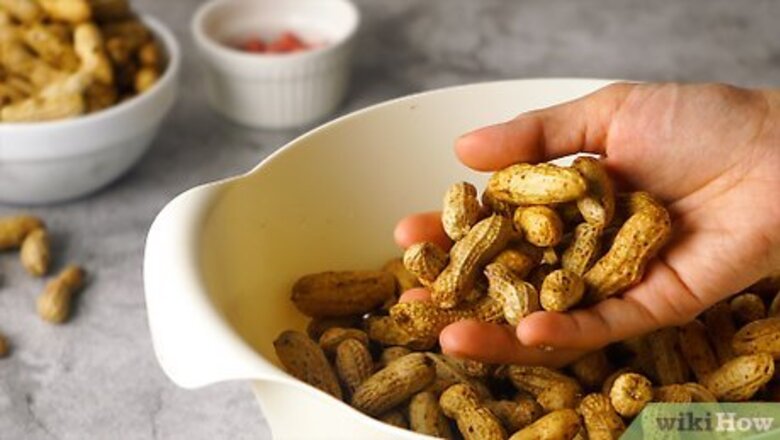
views
Cleaning and Soaking
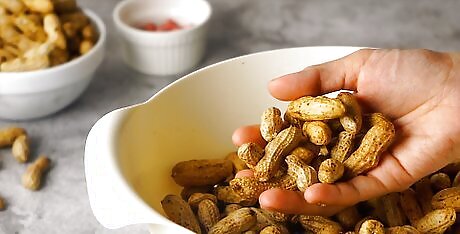
Purchase green peanuts from a farmer's market, farm stand, or grocery store. Look for green peanuts anytime between June and September at your local farmer's market or grocery store. If you live in the Southeast where peanuts are grown, you may notice signs during the summer that advertise fresh peanuts being sold at roadside farm stands. Purchase roughly two pounds of fresh peanuts to boil. Fresh, green peanuts do not last for longer than a few weeks, so make sure not to buy more than you can boil within that time period. Look for fresh peanuts with a firm, brown shell and a strong nutty smell. Green peanuts do not actually look green. Their name refers to the fact that they have been recently harvested and not dried.
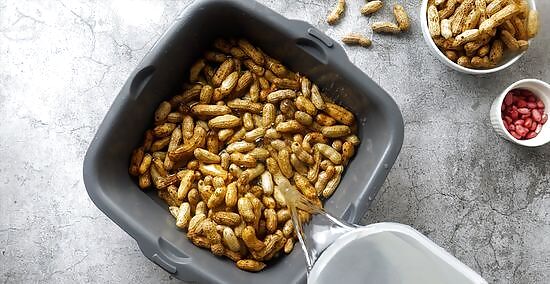
Rinse and remove any debris or broken shells. Place the peanuts in a large bucket and fill it with warm water. Green peanuts from a farmer’s market or road-side stand may still contain debris such as grass, branches, or leaves from the farm. Remove and discard any debris that may float to the surface. You won't need to wash pre-packaged peanuts purchased from a store. Instead, you can open the bag and go straight to soaking them. You can also remove any broken or damaged peanut shells that you spot. Depending on how dirty they are, you may consider doing this outside. If you can work outside, consider using a water hose to spray the peanuts inside of the bucket to remove any debris.

Scrub the peanuts with a brush and add them to a colander. Use a vegetable brush to gently scrub away any dirt that remains on the peanut shells. Scoop up a handful of peanuts at a time from the bucket of water and gently scrub the shells as they rest in the palm of your hand. Place the scrubbed peanuts into a colander for rinsing. Repeat this process until all the peanuts have been scrubbed. You can use a dish-washing brush if you don’t have a vegetable brush handy. Your hands could be submerged in the water for a long period of time, so consider wearing rubber gloves to protect your skin.
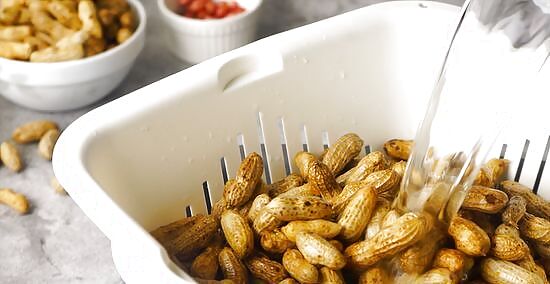
Rinse them with water. Place the large colander full of peanuts into a sink and thoroughly rinse with running water. You’ll need to remove any excess dirt or debris that you loosened from the peanut shells while you were scrubbing them. Continue rinsing the peanuts while gently stirring them around the colander until the water runs clear. If you are working outside or with a large batch of peanuts that won’t fit in your sink, you can also rinse the peanuts outside with a water hose. Keep in mind that it will be more effective to rinse your peanuts while they are in a container with holes that allow the dirty water to easily pass through.

Fill a large pot with 2 pounds (0.91 kg) of peanuts and 2 gallons (7.6 L) of water. Transfer them from your colander to a large stockpot. Fill the pot with water, making sure all the peanuts are fully submerged. If the peanuts float, gently press them down with your hand to make sure every shell is soaked by the water.

Add 1 cup (240 ml) of salt to the water. Measure and add the salt to your pot, stirring to make sure that it completely dissolves in the water. The salt will give the peanuts flavor as they soak. Keep in mind that you will be adding additional salt and seasonings later when you boil the peanuts. Be careful not to over-salt them now during the soaking stage. Use table salt instead of rock salt as it will dissolve in the water more easily. Adjust your ingredient measurements as necessary.
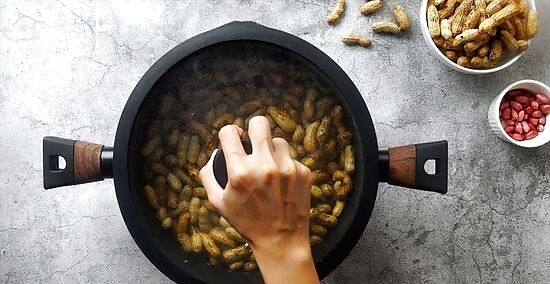
Cover the pot and allow them to soak for 30 minutes. Cover your pot with a lid or plastic wrap to ensure that the peanuts remain submerged in the water. Allow them to soak for around 30 minutes before cooking. Raw, dried peanuts are available year-round and are a great alternative if you do not have access to fresh, green peanuts. Dried peanuts will require a longer soaking time before cooking, so leave them to soak for at least 8 hours or overnight. Soaking the peanuts ensures that they will soften more easily when they are cooked, giving them their delicious texture. Do not attempt to soak roasted peanuts. Roasted peanuts will not soften regardless of how long they are soaked or boiled.

Drain the soaking water. Place your colander in a sink and pour in the water and peanuts from your soaking pot. After the desired soaking time has been reached, you’ll need to remove the soaking water before cooking them. If you are working with a large batch of peanuts and your soaking pot is too heavy to lift easily, consider transferring the peanuts from your soaking pot to a cooking vessel with a slotted spoon. The peanuts are now ready to be boiled.
Cooking, Draining, and Storing
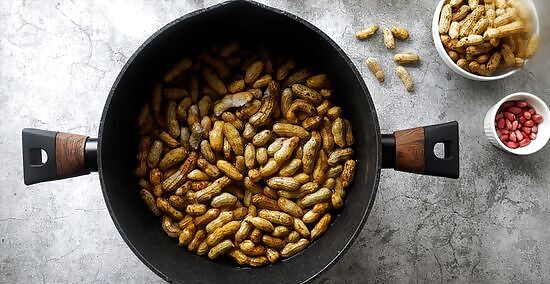
Add the peanuts and your preferred seasonings to a large pot. Place the pre-soaked peanuts and some water into a large stockpot. Make sure there is at least 2 inches (5.1 cm) of water above the peanuts, and stir the peanuts as necessary to ensure that they are fully submerged in the water. Place the pot on your stove and add any desired seasonings. Adding salt is a great, basic seasoning that will add flavor. You can add around 1 cup (240 ml) of table salt for every 1 gallon (3.8 l) of water. If you’d like the peanuts to taste spicy, consider adding red pepper flakes or jalapenos.
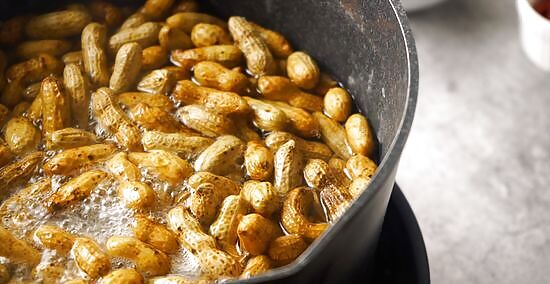
Bring the pot to a boil, then allow the peanuts to simmer for around 4 hours. Adjust your stove temperature to high until the water reaches a rolling boil. Cover your pot and reduce the heat to medium-low and allow the peanuts to simmer. Allow the green peanuts to simmer for around 4 hours. If you are using dried, raw peanuts, allow them to simmer for at least 10 hours. Consider cooking the peanuts in a large crockpot if you have one. This is an especially useful cooking method if you are boiling raw peanuts, which need to be cooked for a long time. Simply add the peanuts, water, and desired flavor seasoning and cook while covered on the lowest heat setting from around 20-24 hours. Periodically stir and add more water to the crockpot as necessary while they cook.

Stir and taste occasionally. Use a slotted spoon to occasionally stir the peanuts as they simmer. Periodically remove a peanut from the pot with a spoon, remove it from its shell, and taste it to determine whether it needs more seasoning or cooking time. How long you cook the peanuts depends on your own personal peanut preference. Some people like their peanuts to be very soft, while others prefer that they retain some of their firmness. Testing throughout the cooking process will help you achieve the perfect doneness. You may need to add extra water to your pot if the water level drops below the peanuts while they cook.
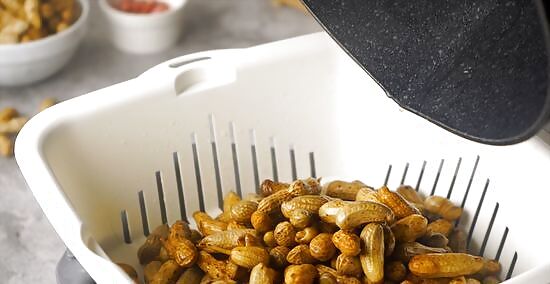
Dump the peanuts and water into a colander. Turn off the heat, then lift your stock pot to carefully dump the contents into a large colander that has been placed in the sink. Once the peanuts have finished cooking, you’ll want to completely remove all of the cooking water before eating them. Use extreme caution when lifting your pot and pouring it into the colander as the boiling water could cause a painful burn. Consider wearing long oven mitts to protect your wrists and arms while handling the pot.
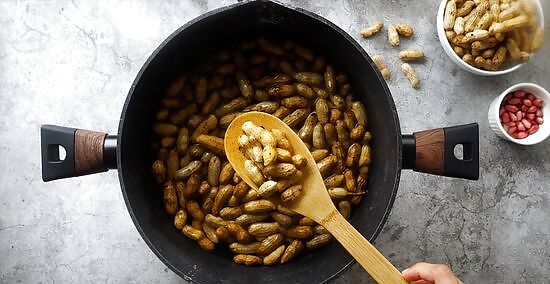
Remove the peanuts with a slotted spoon if the pot is too heavy. Use a slotted spoon to remove the peanuts from the cooking pot if it is too difficult to lift. Place the peanuts directly into a serving bowl. If you’ve chosen to cook your peanuts in a crockpot, the slotted spoon might be the easiest method by which to remove your peanuts from the water.
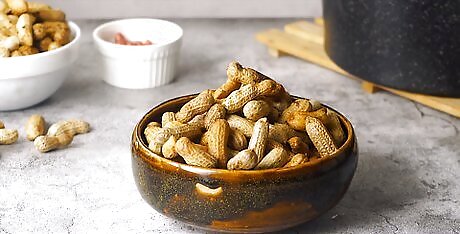
Enjoy immediately or properly store them for later. Allow the peanuts to cool until they are comfortable to touch by hand, then shell them as you eat! Package the peanuts in a Ziploc bag to store them for up to seven days or to freeze them for later. Boiled peanuts do not have a long shelf-life and can’t be kept longer than about a week in a refrigerated, covered container without spoiling.















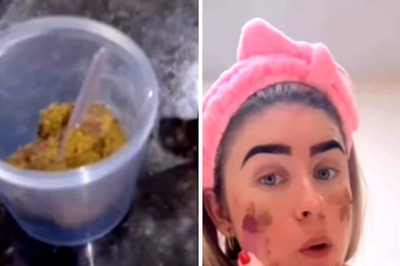




Comments
0 comment